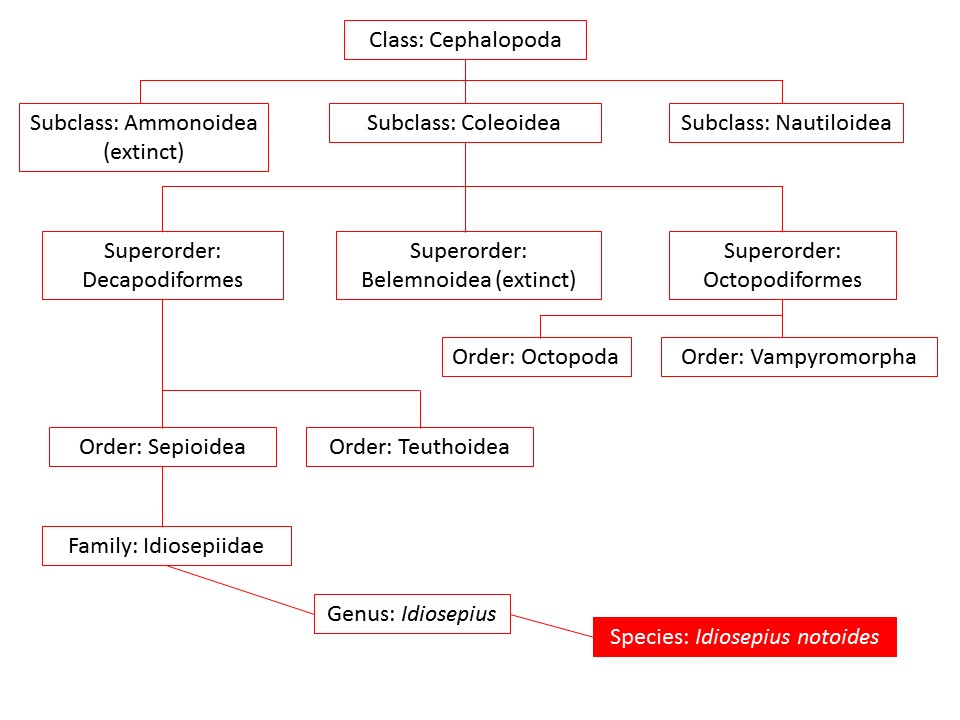Evolution & Systematics
Cephalopoda is a class of the Phylum Mollusca with about 700 extant species, and around 10,000 extinct species (Ruppert et al. 2004). They evolved from a simple monoplacophoran-like ancestor during the Cambrian period, around 530 million years ago (Ma). Early cephalopods are common in the fossil record (Kröger et al. 2011) because they still retained their external shell which fossilises more readily than soft body parts. This shell included a living space and the innovation which allowed cephalopods to give up the mostly benthic lifestyle of their molluscan ancestors and move into the water column: floatation chambers that could be filled with gas, making them neutrally buoyant (Boyle and Rodhouse 2005). This step was the first on a long evolutionary journey that has seen the cephalopods radiate into the many and diverse forms found today.
These early cephalopods gave rise to four groups, the ammonoids and belemnoids which are now extinct, and the extant nautiloids and coleoids (Ruppert et al. 2004). Coleoids, which include the majority of cephalopods living today (squid, cuttlefish and octopods), are united by having internalised, or completely lost, the shell. During the late Palaeozoic, approximately 276 Ma, a divergence in the coleoids produced the Decabrachia (squid and cuttlefish) and the Vampyropoda (vampire squid and octopods) (Kröger et al. 2011). There is some variation in the naming of these groups which can cause some confusion. Ruppert et al. (2004) call them Decabrachia and Octopodiformes (which includes two sister taxa, Vampyromorpha and Octopoda); and others use the terms Decapodiformes (squid and cuttlefish) and Octopodiformes (vampire squid and octopods) (Grasso and Basil 2009, Young et al. 2012; Young et al.2012a; Mangold and Young 2013). The latter nomenclature will be used here.
The oldest known fossil of a cephalopod comes from the middle Late Cambrian, over 500 Ma, and the divergence of the coleoids has been estimated to have occurred in the early to middle Permian, approximately 276 Ma (Kröger et al. 2011). They have evolved into highly efficient predators with sophisticated sensory systems and a complex central nervous system that processes the information gathered by these. They possess features that are similar to the vertebrates, such as the eyes, an example of convergent evolution (i.e. the features are analogous, having evolved in response to similar selection pressures encountered, rather than homologous, evolved from a common ancestor). Cephalopods are highly intelligent and like vertebrates, can learn and solve spatial problems. It is hypothesised that these adaptations evolved under heavy selection pressure in times of high competition, among the various species of ancient cephalopods, as well as with early jawed fishes and then the bony fishes (Grasso and Basil 2009). It is this ‘coevolutionary arms race’ against the teleost (ray-finned) fishes (Mather and Kuba 2013), as well as the predatory pressures from elasmobranchs (cartilaginous fishes, i.e. sharks and rays), marine reptiles and, in the later period, marine mammals during these radiations, that is thought to have shaped the complexity of the coleoid forms and behaviours we see today (Messenger 2001).
The Decapodiformes are so called because their foot has evolved to have ten appendages, eight arms and two tentacles (Young et al.2012). The Octopodiformes have two tentacles as well, but are characterised by having lost one pair of arms, leaving them with only eight appendages (Young etal. 2012b). The Decapodiformes are divided into two orders, Sepioidea (which includes cuttlefish) and Teuthoidea (squids), the largest cephalopod taxon (Ruppert et al. 2004).
Although commonly called “squid”, I. notoides is a member of the order Sepioidea and therefore more closely related to the cuttlefish than to the Teuthoidea, the “true squid”. Family Idiosepiidae contains the single genus, Idiosepius, with approximately eight species (Mangold 2013).
The phylogenetic relationships and evolutionary milestones of cephalopods are being revised and updated as new molecular techniques and fossil discoveries provide fresh insights into the evolution of these diverse and successful animals (Kröger et al. 2011).
|

|
|
A phylogenetic tree showing the major cephalopod taxa and their relationships. Below the level of order, only taxa to which I. notoides belongs are shown for simplicity.
Diagram by Samantha Reynolds with reference to Ruppert et al. (2004) and Grasso and Basil (2009).
|
|